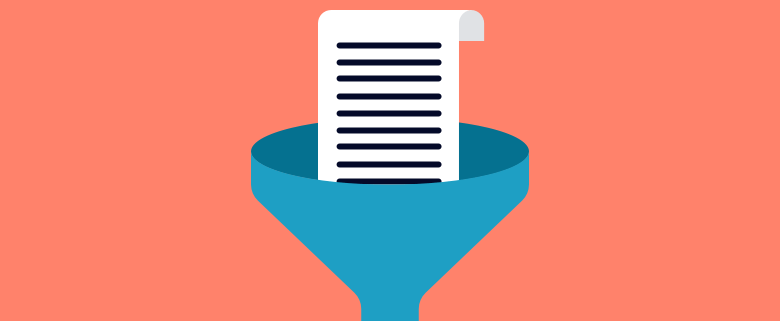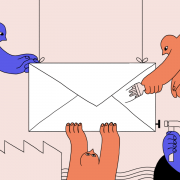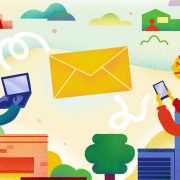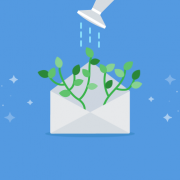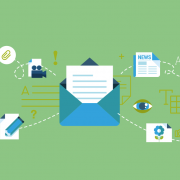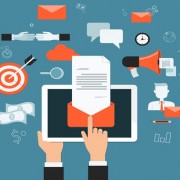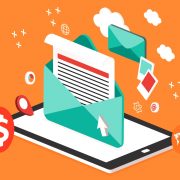Beyond Newsletters: How to Build an Email Sales Funnel That Converts
Email marketing is a digital channel that has withstood the test of time. Where others have disappeared, it has remained strong.
According to Statista, over 293 billion emails are sent and received each day. With so much volume, your email sales funnel needs to stand out or it’ll be lost amongst the noise. That’s easier said than done if you don’t have a solid plan.
This article will walk you through what an email sales funnel is, what it should have, and how to structure it for maximum results.
What is an email sales funnel?
An email sales funnel is a series of emails you send to nurture subscribers and turn them into customers. It can take many forms with some marketers choosing to implement behavioral triggers and conditional logic when sending emails. Others send a predetermined sequence of emails that doesn’t adapt to changing behaviors.
The first option with behavioral triggers is far more difficult. Why would you go through the trouble of creating a personalized email sequence when it’s harder? The results speak for themselves. Marketers have reported 760% more revenue and 26% more opens when using personalized emails.
You’re able to achieve more engagement, opens, and build a deeper connection with your subscribers. You send them relevant content and offers that they’re more likely to view, purchase, and share.
In this article, you’ll also learn how to implement simple segmentation in your email sales funnel so your messages are more relevant and your conversions increase.
What your email sales funnel should do
An effective email sales funnel does more than present offers to subscribers. If it only tries to sell, it won’t get you the results you’re looking for. There are four key pillars of your sales funnel.
Instill buying beliefs
For every product or service, there are specific beliefs that a person has to hold before they buy it. These are called buying beliefs. If prospects don’t have those beliefs, they won’t see the value in the offer and will ignore it.
An example of a strong buying belief many people hold is the power of education – both formal and informal. It’s considered the best way to improve someone’s circumstances and that belief is why many people will take out large student loans.
In the image above, Proof instills the belief that their product increases conversions and backs that statement by mentioning their thousands of customers. Going forward, prospects will believe they can get similar results.
Determine the buying beliefs your prospects should have before they’re able to confidently purchase.
Keep people engaged enough to open your next messages
If people don’t stick around long enough to see your pitch, they can’t buy anything. Your job throughout your email sales funnel is to keep your subscribers engaged. They should be happy to open your emails, reply to your questions, and click your links.
How do you make that happen?
Storytelling.
Average stories are boring because they’re not told properly. At its core, a good story has 3 things.
- A hero. Someone the reader can root for.
- A goal. Something the hero wants to attain.
- A conflict. The thing that makes it difficult for the hero.
Even stories that have all three elements can run into another problem. The hero, goals, and conflicts all serve the business directly. The hero is the business, the goal is to make money, and the conflict is people not converting. This kind of story won’t capture the hearts of your reader because they can’t relate.
Instead, make the reader (or someone just like them i.e your target market) the hero. Make the goal something your subscriber can relate to and Introduce conflicts similar to what they’re experiencing in their lives.
Another important element is continued engagement – anticipation. If you watch any TV series, you’ve probably experienced this. At the end of episode, another plot twist surfaces and you’re left wondering what could happen next. Of course, you tune in to watch.
You can use the same device, known as an open loop, in your emails. You start a story in one email but don’t end it in the same email. It builds anticipation for what’s coming next.
For example, “he thought it was over and he would never lose the weight – until he stumbled on a Facebook post that changed everything. I’ll tell you what happened in the email I send in 2 days so be on the lookout.”
Build trust
The other aspect your email sales funnel has to nail is establishing trust. Even if someone has the right buying beliefs, they won’t buy your product unless they trust you. A clear example of this is the online course industry.
There are tens of thousands of people selling courses but only a fraction of them make more than $100,000/year. Is it because their content is inferior or they’re targeting the wrong market? That’s a possibility but, more than likely, it’s because they don’t have the trust of their audience. There are multiple ways to do this but the most powerful is social proof.
Marie Forleo does this masterfully with her success page. Former students talk about how her training and the community inspired them and helped them achieve something more.
Sell products
Of course, your email sales funnel needs to sell and you can, technically, present a new product in every message but it’s not recommended (unless you’re in retail marketing). Instead, I encourage you to vary the way you sell by alternating between soft sells and hard sells.
A soft sell is a subtle mention of the product in a way that’s relevant to what you’re talking about. A hard sell is when the focus of the message is on getting the reader to buy the product.
A lot of email sales funnels only focus on the hard sell. That’s a mistake because some people are turned off by being constantly sold but don’t mind when you subtly mention a product.
Segmenting subscribers so your messages are more powerful
The last thing to touch on before laying out the email sequence is segmentation. This is one of the most important aspects of your email sales funnel. Sure, your audience is made up of similar people but each one has a different goal.
For example, a business that sells online education about Facebook marketing and advertising would have marketers, entrepreneurs, and consultants interacting with its content. It shouldn’t talk to each of those people the same way. The entrepreneur is building their own business, the consultant is helping a client, and the marketer is working for their boss.
Their goals would be completely different so your messaging needs to appeal to each group separately. Here are three segmentation methods to get you started.
Based on what they signed up for
A well-optimized website has many different lead magnets, content upgrades, landing pages, and popups to grow its mailing list. Naturally, these things will appeal to different segments of their target market. You can make an educated guess about their interests based on what they signed up for.
For example, a fitness brand may cater to people who are beginners, intermediate, and advanced. It would have blog posts and lead magnets that address each of those audiences. Someone who signs up for the advanced guide to cardio training already knows the basics. The follow-up email sales funnel would position the product it sells as an advanced solution.
In the example above, the lead magnet is focused on product launches. When someone signs up they get emails relevant to launching products and the final pitch contains language that also talks about product launches.
Using survey opt-ins or quizzes
Another method segmentation method is using an opt-in survey or quiz. These have the added benefit of allowing your subscribers to tell you exactly what they want (or don’t want).
When you send follow-up emails, you’re 100% sure you’re sending messages they’re interested in. This alone can have a huge positive impact on your email sales funnel.
In the image above, Melyssa Griffin presents three options. When a visitor selects one before signing up, the emails they get are tailored to their situation. It also makes it easier for her to pitch the right product to them down the line.
Asking within your first few emails
This strategy is useful when you have a general lead magnet on your website that can appeal to almost all of your visitors. Instead of assuming they want something, you’re able to get them to tell you exactly what they expect from you. Most email marketing services like ActiveCampaign or Moosend allow you to set up email automations to score, split, or change email sequences based on actions people take.
In the image above, the most important issues subscribers face have to do with sending relevant emails and getting more subscribers. Depending on the option they click on, they’re segmented and sent messages in line with their needs.
Designing your own email sales funnel
Your email sales funnel can have as many emails as you want but there’s a specific sequence that it should follow. It introduces you and your business, establishes how you’re a credible business/person, instills the beliefs your prospect needs to buy, and asks for the sale.
Many people get hung up on how many emails you need to do this and when you should start pitching. There’s no hard and fast rule for this and it depends on your audience, the kind of products you’re selling, and the price point.
For example, a $2,000 course would require more effort and a different approach than a $20 accessory. The course is an investment while the accessory is an impulse buy. That doesn’t mean you can skip any of the elements. It just means you can condense the process into a single email or two.
Email 1: Introduction, segmentation, open loops
The first email sets the tone of everything else. You want to open up strong, introduce your brand, segment subscribers (if you’ve not done so already), and encourage them to read the next email you send.
When you’re introducing yourself, it’s not about sharing your accolades, the focus should be on:
- How you’re different
- What they stand to gain by opening and engaging with your emails
- What they should expect
When you’re done with your introduction, consider asking them to reply to your email to identify engaged subscribers. You can also lead users to specific content or actions they can take right now. Finally, use an open loop that keeps them engaged. Tell them what you’re going to share in the next email and why it matters.
The email above is long but it has a lot of humor and introduces the people behind the brand. It also tells a short story that is used as an analogy for what to expect from them. Finally, it leads you to a few interesting links relevant to their podcast which establishes social proof and allows readers to engage with the brand right away.
Email 2: Buying beliefs, stories, credibility
In the second email, your job is to instill a few of the beliefs people need before buying your product.
Unfortunately, you can’t simply tell someone that your product will make them better because of XYZ. Instead, take a past client/customer and tell their story. This helps establish your credibility without explicitly stating how amazing you are.
If you don’t have a past client, create a story of transformation that someone would experience with your products. You don’t have to make yourself the guide but tie it into your overall messaging. For example, if you offer consulting services for small businesses, you can create a story about how a small business met a consultant and changed everything.
Email three: Buying beliefs, outcomes, soft sell
Email three continues to instill buying beliefs. The amount of time you spend depends on what someone needs to believe. If the product is more expensive, you’ll spend more time driving these points home. The same is true if it’s an unusual product.
Begin talking about the outcomes people can expect when they buy your product or sign up for your service. Will they get more traffic? Will they achieve wellness? Is it about financial independence?
Phrase these outcomes as questions. For example instead of “you’ll make more money”, ask them “how would it feel to be debt-free in the next two years?” This is called future pacing and it’s a powerful way to help people envision the outcome for themselves.
Introduce your product here and invite people to take a look but don’t sell it too hard.
Email four: hard sell
By the time you roll around to the fourth email in the email sales funnel, you’ve created the right buying beliefs, established credibility, and have introduced a product. It’s time to sell.
A hard sell doesn’t mean you alienate your subscriber. It just means you’re direct when asking for the sale. Instead of subtle mentions, you try to convince them to buy.
These are features, benefits, and links to buy. Don’t overthink this because it’s more important to write it and put it out there so you can use data to improve it over time.
Email five: FAQs and soft sell
There will be people who don’t buy from the last email and that’s OK. Usually, there are unanswered questions that need to be addressed. This is the focus of your FAQ email.
When answering questions, turn it into an opportunity to let your product shine. For example, if a common question is “what if I don’t have much free time to use the course.” You can turn that into a strength by saying something along the lines of “We took that into consideration when building the course. There are no deadlines and the content isn’t dripped out every week to create a sense of urgency. It’s 100% self-paced and you can finish it in one week or a few months. It’s up to you.”
Your FAQ is basically a knowledge base that answers the most pressing questions they have. You’re also soft selling by adding in links to your product page. Avoid justifying your price directly. This will remove credibility from the product.
Email six: Final reminder and restarting the process
You can’t sell forever and if you try, people will unsubscribe. The last email in your sales funnel allows you to move on to the next product in your catalogue. At the very top of the email, include a reminder about the product you’ve been talking about.
After that, restart the process at email two but focus all of the messages on the next product. Taking this approach allows you to continually pitch new products without tiring out your subscribers.
The major difference between the first email sales funnel and subsequent ones is the timing. When someone first signs up, they’re more engaged so you can get away with sending emails more often.
Over time, it can become annoying. With your second email funnel, space the message a few days apart so fatigue won’t set in.
Conclusion
This article has covered a lot of ground about email sales funnels. When you’re implementing your own, focus on the value you’re delivering to your subscribers instead of what you stand to gain.
If your messages come off as superficial and uninspired then few people will buy what you’re selling. Instill the right beliefs, educate, and sell. If you get it right, you’ll see a huge uptick in conversions and goodwill.

